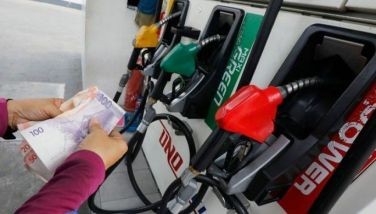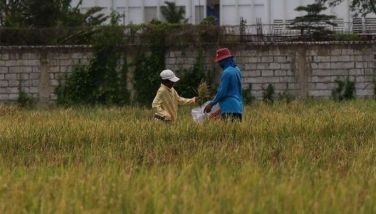Geothermal energy

If the war in the Middle East escalates, the price of oil may rise to as much $100 per barrel or more from the current $87. If there is a repeat of the Arab boycott following the Yom Kippur War in the 70s, the West will be denied oil supply as a way of hitting back on the West for supporting Israel.
An oil price spiral will also make the price of coal, natural gas and geothermal go up because these are indexed to oil prices, a policy designed to encourage investments in non-oil power sources.
If the West is denied oil supply, we may have to negotiate a government-to-government crude oil supply agreement with Saudi Arabia, Kuwait and a few other countries like we did in the 70s. Today, it will be a bit more complicated because our oil companies buy refined products from the open market. Refined products are produced by Western oil companies like Shell in Singapore that will be denied crude oil to refine like in the 70s. Today, only Petron has a refinery that can process crude oil the government can get through a G-to-G supply arrangement.
If the war ends up closing the Straits of Hormuz where about 30 percent of the world’s oil requirements passes daily, oil prices will go a lot higher than $100 per barrel.
The volatile politics of oil taught us good lessons back in the 70s. We were almost totally dependent on petroleum with only about four percent accounted for by hydro. We started looking for whatever local energy resource we might have. Unfortunately, our initial oil exploration didn’t produce much. The best resource we found was geothermal energy.
Geothermal energy was the only domestic energy resource other than hydro that could be used as baseload for our power grid. Our geothermal pioneer was Dr. Arturo Alcaraz, who helped a team of geologists from PNOC EDC with the assistance of scientists from New Zealand to develop this resource from scratch.
I recall spending days in Tongonan, Leyte with our exploration team. Pablo V. Malixi, one of the senior VPs PNOC inherited from Esso was assigned to fast track the development of geothermal. The methodical approach of Malixi and the dedication of his small group of geologists and engineers proved there was enough geothermal resource to power an initial 110 MW power plant.
After Tongonan, the Palimpinon field near Dumaguete was also developed. Then came Bacon Manito in Albay and later, Mount Apo. In the meantime, Union Oil was working on Tiwi and Makiling-Banahaw. Before long, we were the second largest producer of geothermal power in the world, after the Union Oil California field.
Today, EDC, now owned by the Lopez Group, is the country’s largest geothermal producer. With 12 geothermal stations in the country, EDC is the world’s largest vertically integrated geothermal firm – i.e. full control over the wells, steam field, power plant itself, down to the selling of the power generated. EDC has installed capacity of 1,179 MW out of the over 1,900 MW we have today. Other geothermal developers include Philippine Geothermal Production Co. (PGPC of the SM Group), Maibarara Geothermal (PGEC/PERC (Yuchengco]/Phinma Energy/PNOC RC), and AP Renewables (Aboitiz Power).
I asked Rufino Bomasang, a pioneer geologist in PNOC I worked with, if we have more geothermal energy resources we can develop. His response:
“Yes, Boo, there are potential sites that can be developed to add to the current geothermal capacity. In the Cordilleras alone, potential geothermal sites had been identified by technical staff of the old PNOC-EDC and the Ministry of Energy and its successor agencies (i.e. Office of Energy Affairs under the Cory Aquino administration, which I once headed, and the Department of Energy, where I was the first undersecretary during the Ramos administration).
“Among these sites are Batong Buhay in Kalinga, Mainit in Mt. Province, Buguias and Daclan in Benguet and Tinoc in Ifugao. PGPC of the SM Group has so far been the most active in conducting further exploration work in the Cordilleras, especially in Kalinga where it has been allowed to drill.
“One of the main constraints to energy (and mining) projects in the Cordilleras has been opposition from local residents, most of whom are my fellow indigenous people (e.g. Kalingas, Bontoks, Ifugaos, Ibalois, etc.). This is currently being resolved through the Free and Prior Informed Consent process under the Indigenous People’s Rights Act. This, however, is usually a long and tedious process.”
For its part, EDC has geothermal projects on the drawing board such as Amacan in Davao de Oro; new wells in Leyte; binary plants which use brine from existing geothermal power facilities in Leyte, Sorsogon and Negros Island; and greenfield concessions, including exploration licenses at the Buguias-Tinoc geothermal site in the Cordillera region and the Mt. Sembrano Geothermal Power Project in Southern Luzon.
But like oil exploration, developing geothermal is not for the faint hearted with shallow pockets. Drilling remains the single largest expense in the development of new geothermal fields. EDC plans to drill 40 new wells over the next three years with capital investments of P60 billion to sustain and expand the operations of its geothermal projects.
“The main focus of EDC over the next three years is to make sure that we can continue to deliver the amount of renewable source of geothermal for our customers,” according to EDC vice chairman and CEO Francis Giles Puno.
Most of EDC’s drilling operations will be in Leyte and Mt. Apo in Mindanao. The company owns and operates the 232.5-MW Malitbog, 180-MW Mahanagdong, 125-MW Upper Mahiao, 123-MW Tongonan and 50.9-MW Optimization geothermal projects in Leyte.
Perhaps it is time for the government to give more incentives to help mitigate the high cost of drilling needed to find out if we have more geothermal resources we can use.
Boo Chanco’s email address is [email protected]. Follow him on X @boochanco
- Latest
- Trending





























